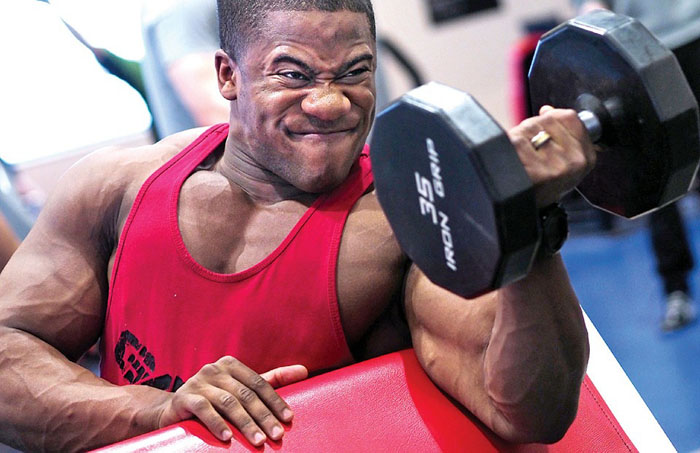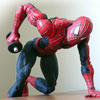Would you like to know how to get more out of every single dumbbell curl you do? Amazingly enough, you can do this simply by changing where you grip the dumbbell.
First, I'm going to tell you what the trick is, then I'm going to tell you exactly how and why it works. Then I'm going to finish by telling you how to make the trick so powerful it'll blow your mind!
In a nutshell, instead of gripping the handle in the middle (as is normally taught), grip the handle with the thumb and forefinger side of your hand pressed up against the inside of the dumbbell plates. There will be a space of several inches between your pinky and the other side plates.
To take full advantage of this change in your grip, start the curl with your palms facing in to your thighs, otherwise known as a neutral or hammer grip. As you curl up, rotate your forearm so that your palm is facing up at the top of the movement. You should feel a strong cramping in your biceps.
Here's how and why it works:
The biceps muscle has two main functions. The first is flexing the elbow (in essence, bringing the forearm closer to the upper arm like when you bend your arm to scratch your nose). The other function is called supination, which is a biomechanical term for forearm rotation. Supination occurs when you turn your hand from a palms-down position to a palms-up position.
The traditional dumbbell curl without forearm rotation addresses the flexing function of the bicep. Rotating your forearm as you curl the dumbbell up invokes the supination function of the bicep, working more of the muscle mass of the bicep and giving you a stronger contraction.
Holding the dumbbell off-center essentially adds resistance to the supination function of the bicep muscle. If you think about it, when you hold your hand in the middle of the dumbbell, the two ends are balanced like two identical-weight people on a see-saw. You get very little, if any, resistance on the supination.
By holding the dumbbell off-center, you tip the balance of the dumbbell towards the pinky side of your hand. Your bicep must then work against resistance to accomplish the supination, adding in more resistance to the curl movement.
This resistance translates into more efficient work for the bicep and, ultimately, more results for you!
 the bicepo curl exercise
the bicepo curl exerciseNow I'm going to tell you how to adapt this trick into something that will make your jaw hit the floor on the first rep you do.
You've learned about supination and adding resistance to the supination movement by holding the dumbbell off-center. You've felt the difference this makes in your biceps.
Now imagine how much more effective this trick will be if you add actual weight for resistance instead of just shifting your hand over!
In order to accomplish this, you're going to need one of two things: do-it-yourself dumbbells with which you can add or remove weight or Plate Mates (TM), which are small magnetic weight plates that stick to the metal of the dumbbell.
The execution is simple: make a dumbbell with more weight on one end than the other. That's it. For example, place 20 pounds of weight on one end and 25 pounds of weight on the other.
Grip the dumbbell in the middle when you use it, making sure that the heavier end is on the pinky side of your hand. If you are using Plate Mates (TM), stick a few of them onto only one side of the dumbbell to accomplish the same imbalance.
Now when you curl up and supinate, your bicep is going to have that added resistance on the supination movement. The cramping sensation you get on the very first rep as you come to the top and squeeze the muscle hard will show you just how powerful this technique is. The pump you get in your biceps after your set will seal the deal!
You will also notice that your forearm and grip are getting a lot of work with this trick. This is just icing on the cake and will not decrease the tension on your bicep in any way.
Note: If you are using dumbbells that weigh less than 30 pounds total, I would recommend you use a 2 1/2 pound plate on one side rather than a 5 pound plate. Any more than 30 and you should use a 5 pound plate.
Being a dedicated trainer myself, I love to hear how well my tips work for other people. It would be really gratifying to hear from you about how this technique worked for you or any suggestions you might have as to how to make it more effective.
You can send your comments to me at betteru@fitstep.com.
And, when your biceps are so pumped and sore that you can barely brush your teeth the next day, be sure to tell everyone who will listen to you who did this to you: Nick Nilsson at Fitstep.com!
Related Pages
- Go here for bicep curl technique
- Bicep curl max fitness test and the arm curl test.
- Free weights for sale in the fitness store.
- Discussion about fitness exercise technique
- Complete list of fitness exercises


 More About Dumbbells
More About Dumbbells Upcoming Events
Upcoming Events